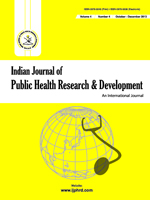Ocular Trauma-Spectrum of Ultrasound Findings: a Prospective Study
Subscribe/Renew Journal
Introduction: Ocular trauma is a common co-existing injury, often missed, in poly-trauma. Delayed diagnosis may lead to vision threatening consequences. It is important to diagnose it early so as to prevent ocular morbidity.
Patients and Methods: A prospective observation study comprising 50 patients with positive Ultrasound findings referred to our department and having history of ocular trauma. Ocular Ultrasound was done and various findings were recorded and analysed.
Aims and Objectives: To study the spectrum of ultrasound findings in ocular trauma and to advocate the liberal use of Ultrasound in this clinical setting.
Observations and Results: The age of the patients in the sample ranged from 8-63 years with mean age being 26 years. The commonest pathologies to be encountered were vitreous haemorrhage and anterior chamber abnormalities. Foreign body detection and retinal detachment followed thereafter. Other abnormalities of globe, lens, retinal detachment and choroid detachment were also observed and analysed.
Conclusion: In our study, the higher percentage of major ophthalmologic findings like vitreous haemorrhage and anterior chamber abnormalities appear to be due to the fact mainly those patients, in whom clinical examination was not possible, were referred for ocular Ultrasound examination. These included ones in whom eyelids were either swollen or had open injuries, and also in whom posterior chamber was inadequately visualized due to anterior chamber rendered opaque by injury. The study showed that ultrasound is an excellent modality to diagnose extent and nature of ocular trauma. Thus we propose liberal use of ocular ultrasound in an emergency setting of ocular trauma.



